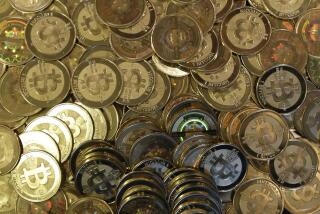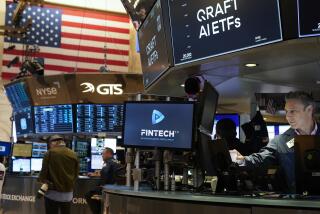Investors stampede into a modern-day silver rush
Kristen Hammond didn’t have to think too long about a suitable investment to give her three young children to mark their birthdays this year.
Bypassing such traditional ideas as a U.S. Savings Bond or a share of blue-chip stock, she decided to give each child a 1-ounce coin of pure silver.
Whether they know it or not, the Hammond offspring are participants in a modern-day silver rush. Stoked in part by voracious demand from small investors, the gray metal has rocketed 46% since the end of December, the biggest gain of any major commodity.
Worried about the U.S. government’s soaring debt load, the Federal Reserve’s easy-money policy and the slumping dollar, investors have flocked to silver and gold as “hard money” refuges. Buyers such as Jeff Lindsay in Neenah, Wis., say they fear that the government’s finances are spiraling out of control and figure that precious metals offer at least the hope of holding their value if stock and bond markets unravel again.
For the economy, “The worst-case scenario is too depressing to talk about,” said Lindsay, 51, who last year sharply boosted his retirement-account bet on rising silver prices. He owns shares in the ProShares Ultra Silver exchange-traded fund, which is designed so that its value moves twice as fast as the actual price of silver.
Although gold traditionally takes the spotlight as a hedge against global calamity, silver in the last year has been the metallic star. Its price has surged 148% in 12 months, to about $45 an ounce, its highest level in 31 years. Gold, meanwhile, has climbed 29% during that time, though it remains much more expensive, fetching about $1,500 an ounce.
That relative affordability — silver’s nickname is “the poor man’s gold” — has helped polish its current allure. For the cost of a single 1-ounce American Eagle gold coin issued by the U.S. Mint, an investor can own about 33 of the Mint’s 1-ounce silver Eagles.
The Mint has sold a record 15.2 million of those silver coins this year, up 31% from the same period last year. By contrast, sales of 1-ounce gold Eagles have edged up only 3% to 342,000.
Whatever the investment logic behind silver’s boom, experts say the price spike since August has overtones of the dot-com stock mania of the late 1990s and the housing bubble of the last decade.
“The higher it goes in price, the more feverish the buying becomes,” said Ken Edwards, a coin dealer at California Numismatic Investments in Inglewood.
Bill O’Neill, a partner at commodity trading firm Logic Advisors in Upper Saddle River, N.J., worries that investors don’t realize how notoriously volatile silver is, more so than gold.
“Silver is just a huge speculative playground,” O’Neill said. “When it corrects, it’s going to be absolutely vicious.”
Some investors and traders began to head for the exits at midday Monday, after silver futures prices in New York rose to just under $50 an ounce — close to the all-time high nominal price reached briefly in 1980 near the zenith of the commodity-investing mania of that era.
The April futures price fell back Monday to close at $47.15 an ounce, still up $1.09 for the day. But profit-takers swarmed Tuesday, pushing the price down $2.09, or 4.4%, to $45.06, the biggest percentage decline since mid-March.
Gold, which reached an all-time high Monday, retreated $5.60, or 0.4%, to $1,503 an ounce Tuesday.
One catalyst for Tuesday’s slide in silver was a decision by New York’s Comex exchange to increase the minimum down payment needed to buy a silver futures contract, which gives an investor the right to buy a specific amount of the metal at a set price on a specified date. Exchanges typically take such an action in soaring markets as a way to damp excessive speculation.
But silver’s setback Tuesday also may have stemmed from investors’ fear of the Fed’s next move.
The central bank has flooded the financial system with money over the last two years to bolster the economy. Critics, however, say the Fed is devaluing the dollar by keeping credit easy and is encouraging speculators to push up prices of energy, food and other commodities.
As classic hedges against inflation and the eroding purchasing power of paper currencies, silver and gold have been prime beneficiaries of the Fed’s controversial policies. But that also means that demand for the metals could wane if the Fed were to signal that it will begin to tighten credit soon.
Fed policymakers conclude a two-day meeting Wednesday, and Chairman Ben S. Bernanke will hold a news conference after the meeting. Although most economists don’t expect any abrupt policy change, the precious metal markets clearly were nervous Tuesday, traders said.
Still, silver has more going for it than investment demand. The metal also is a bet on continuing global economic growth: It has long been used in industries such as electronics, and now is benefiting from rising use in green industries, including as a coating for solar-power reflectors.
Industrial use is expected to account for 43% of total global silver demand this year, according to Deutsche Bank. Investment demand, including coins and bars, is expected to account for 31% of consumption, jewelry 15%, photography 5% and silverware 4%.
Some individual silver buyers cite persistent rumors that the metal is in short supply because of hoarding.
Alleged manipulation has long been part of silver’s mystique. The all-time high price (unadjusted for inflation) of about $50 an ounce, set in January 1980, was fueled by an attempt by the Hunt brothers of Texas to corner the market with massive purchases of the metal.
That ended in disaster for investors who went along for the ride: After zooming 468% in 1979, silver collapsed in 1980 and ’81. Commodity prices in general plunged in the 1980s and 1990s as supplies rose and investors abandoned hard assets in favor of stocks and bonds. Silver mostly traded between $3 and $6 an ounce from 1984 through 2004.
But prices of raw materials have risen in the last decade, powered by rising consumption in fast-growing emerging economies.
And since the financial crisis of 2008, more U.S. investors have turned to silver and gold as havens, fearing what might yet go wrong as the nation struggles with record budget deficits and a tepid economic recovery.
“I’m seeing a failure to address the debt issue in the U.S.,” Lindsay said.
Hammond, who lives in suburban Washington, D.C., said she cashed in the stocks she held in her retirement account two years ago to buy silver and gold Eagle coins. Silver’s price has since more than doubled.
“No way I feel we’re at the end of this at all,” she said. “People are losing faith in the dollar. I think it’s extremely viable that silver could hit $100 in 2012.”






